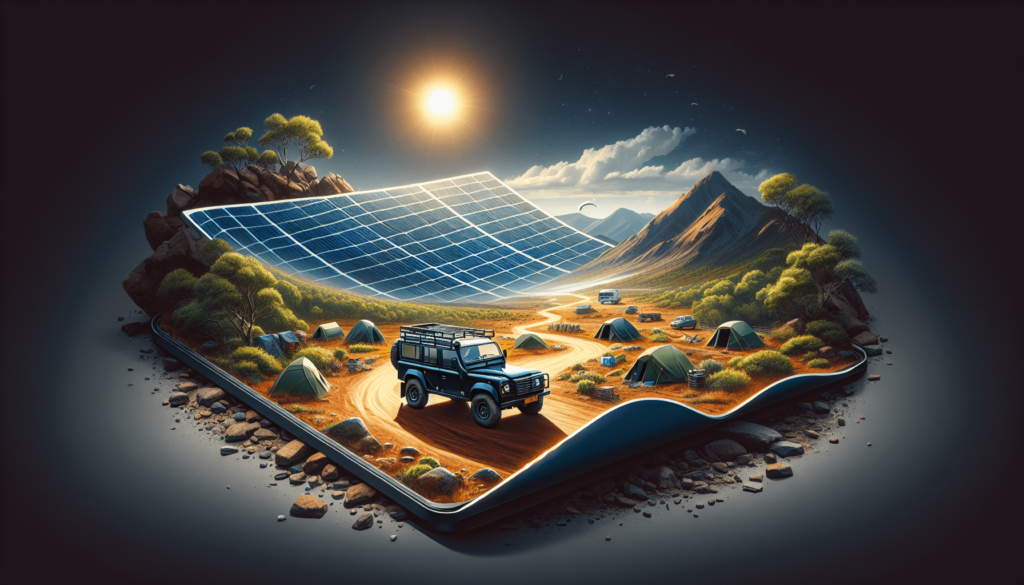Have you ever wondered how to power your adventures while keeping your environmental footprint minimal? For overlanders, having a reliable source of energy can be crucial. This is where portable solar panels come into play. As we look forward to 2025, the options for portable solar panels are expanding, offering more flexibility, efficiency, and ease of use than ever before.
The Growing Need for Portable Solar Panels
As you traverse rugged terrains and remote locations, the demand for a consistent power source increases. Whether you’re charging your phone, running lights, or powering a fridge, having a portable solar panel can make your journey more enjoyable and worry-free. In 2025, advancements in technology mean you’ll find more efficient panels that can provide ample power even under cloudy skies.
Key Features to Consider
Not all solar panels are created equal. Understanding what features matter most for overlanding can help you make the right choice. Here are some vital aspects to think about when selecting your portable solar panel:
Efficiency Rating
The efficiency rating indicates how well a solar panel converts sunlight into electricity. Generally, higher-efficiency panels use less space to produce the same amount of power as lower-efficiency ones. Look for models with an efficiency rating of at least 20% for optimal performance.
Portability
Since you’re overlanding, the size and weight of the solar panel matter. Lightweight and foldable designs make transport easier. Look for panels that can roll up or fold into compact sizes, making them easy to store and set up.
Wattage Output
Determine how much power you’ll need. If you plan to power larger devices or multiple gadgets, you’ll need a panel with higher wattage output. A good rule of thumb is to aim for 100 Watts or higher if you’re using multiple devices.
Durability
Overlanding often puts your gear to the test. Choose solar panels made with robust materials, ideally rated for rugged outdoor use. Water resistance and sun exposure are critical factors to keep in mind, too.
Versatility
Consider panels that offer various ways to connect to your devices. USB ports, DC outputs, and compatibility with battery packs can add significant value. Panels that are easy to link to multiple devices can simplify your setups.

Top Portable Solar Panels for Overlanders in 2025
Now that you have a better understanding of the features to consider, let’s break down some of the best portable solar panels available in 2025. Each of these options brings unique advantages to your overlanding experience.
1. Goal Zero Nomad 200
When it comes to power output, the Goal Zero Nomad 200 stands out. With a hefty 200 Watts of output, it can handle charging various devices simultaneously. It’s also designed to be highly portable, featuring a foldable design that makes it easy to pack away.
- Efficiency: 22%
- Weight: Approximately 22 lbs
- Durability: IP67 water-resistant rating
- Key Feature: High wattage output for multiple devices
2. Renogy E.FLEX 220W
The Renogy E.FLEX is perfect if you’re looking for a blend of efficiency and functionality. With a slim design and a lightweight frame, it’s easy to transport and set up in the field.
- Efficiency: 21%
- Weight: Around 13 lbs
- Durability: Shock-resistant, suitable for rugged conditions
- Key Feature: Lightweight and efficient for significant power
3. Anker 21W Solar Charger
For those who need a compact solution for charging smartphones and small devices, the Anker 21W Solar Charger is a fantastic choice. It’s incredibly lightweight and perfect for day trips or limited power needs.
- Efficiency: 22%
- Weight: 1.5 lbs
- Durability: Water-resistant fabric and solid construction
- Key Feature: Portability without sacrificing efficiency
4. ALLPOWERS 200W Solar Panel
The ALLPOWERS 200W panel offers a great combination of size and power. It’s a bit heavier but provides excellent versatility with multiple output options.
- Efficiency: 20%
- Weight: 17 lbs
- Durability: Built to withstand harsh weather
- Key Feature: Multiple outputs for various devices
5. Nekteck 28W Solar Charger
Another great option for light-duty charging, the Nekteck 28W Solar Charger is small, sleek, and easy to carry. This model is perfect for charging devices on the move.
- Efficiency: 21%
- Weight: 1.2 lbs
- Durability: Lightweight yet sturdy design
- Key Feature: Multiple USB ports for simultaneous charging
Setting Up Your Solar Panel
Once you’ve chosen the right solar panel for your needs, think about how to set it up effectively. Here are some tips to maximize your solar charging experience:
Choosing the Right Location
Position your solar panel where it will receive optimal sunlight. Aim for an unobstructed area without any shade from trees, buildings, or other structures.
Angle Adjustment
The angle of your solar panel can significantly impact its efficiency. Adjust the angle based on the sun’s position during the day to ensure maximum exposure.
Frequent Maintenance
Take some time to clean your panels regularly. Dust and debris can impact efficiency, so maintaining them will ensure they perform at their best.
Connecting to Batteries
Consider connecting your solar panel to a portable battery to store energy for later use. This setup allows you to use your power even when the sun isn’t shining.

Cost Considerations
While investing in a portable solar panel might seem daunting, it can save you money in the long run. Some factors affecting cost include:
Initial Investment
The upfront cost of purchasing a portable solar panel can vary widely based on wattage, brand, and features. Expect to pay anywhere from $100 to $700, depending on what you choose.
Long-term Savings
Using solar energy significantly reduces your need for fuel and external charging sources, which can save you money over time. Consider the long-term benefits when evaluating costs.
Quality vs. Price
While it’s tempting to go for a bargain, consider the quality and performance of the panel. Investing in a reliable, more expensive model can be more beneficial in the long run.
Environmental Impact
By choosing portable solar panels, you contribute to a sustainable lifestyle while on your travels. Here’s how:
Reduced Carbon Footprint
Using solar energy decreases your reliance on fossil fuels. This shift helps reduce greenhouse gas emissions, benefiting the planet.
Encouraging a Sustainable Lifestyle
By leveraging renewable energy sources, you inspire others to consider sustainability in their adventures. Your choice can encourage eco-conscious travel practices.
Supporting Least Damaging Solutions
Since solar energy is abundant, tapping into it decreases the demand for damaging energy sources. This approach helps preserve the beautiful landscapes you explore.
Tips for Maximizing Solar Energy Efficiency
To make the most of your solar energy, here are some practical tips. Implementing these suggestions can enhance your experience while ensuring you have enough power for your needs.
Monitor Weather Conditions
Keep an eye on weather forecasts to adjust your expectations. Cloudy days may reduce solar efficiency, so plan accordingly.
Combine Energy Sources
If possible, utilize multiple energy sources to ensure a stable power supply. Combining solar power with gasoline generators or batteries can alleviate energy shortages.
Use Energy-Efficient Devices
Opt for devices that consume less power. Energy-efficient appliances and gadgets can help maximize what you’re able to charge with your solar setup.
Invest in a Charge Controller
A solar charge controller regulates power flowing to your batteries, preventing overcharging and damage. This investment can significantly enhance the lifespan and efficiency of your battery storage.
Conclusion
Finding the best portable solar panels for your overlanding adventures in 2025 can seem overwhelming, but with the available options and features, you’re well-equipped to make a good choice. Consider the portability, efficiency, power output, and durability when selecting the right panel for your needs.
With the right solar solution, you can enjoy the great outdoors while ensuring you have all the power you need, making your travels even more enjoyable. Remember the impact of your choice on the environment and the potential savings on your adventures. By integrating solar power into your journey, you’re not just powering your devices—you’re also making a statement about sustainable travel.
Let the sun shine on your adventures!

